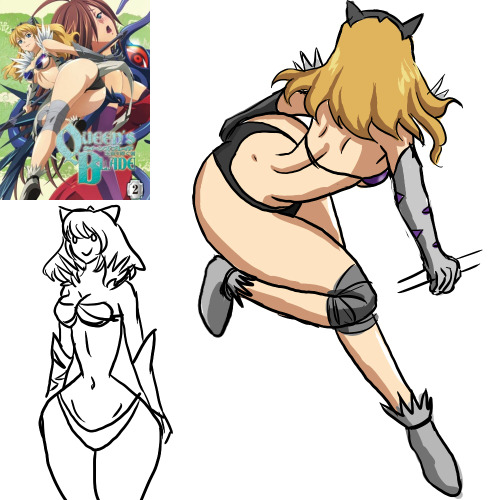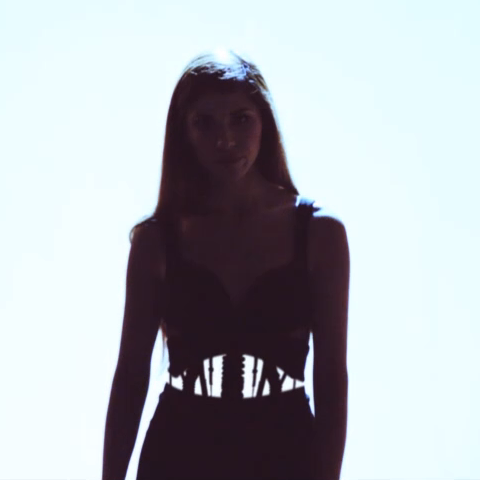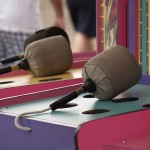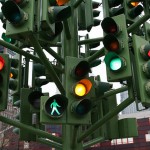This was going to be a short post, but there were a lot of good women to link to, so just think of this post as an epic crossover.
Perhaps it’s not intuitive to go to tumblrs commenting on the questionable anatomy of girls in comic books for smart, incisive commentary on feminism and (sometimes inadvertent) misogyny, but man oh man are you missing out.
I follow Escher Girls, a tumblr that collects professional drawings of superheroines that have something terribly wrong with them (the tags include: organless torsos, gratuitous butts, rubber spines, and boobs don’t work that way). In addition to calling out these bizarre depictions of women, the Escher Girls tumblr fixes some of them with redraws. Sometimes, they show how a more realistic drawing actually looks stronger and more dynamic, and sometimes they show how contorted a picture is by just reproducing the pose from a different angle (click for larger view).
And, in the last week or so, Escher Girls and Girl in Four Colors have been untangling some problematic discussions of women’s bodies as well as their usual topic of illustrations. You see, recently someone started a tumblr called The Hawkeye Initiative, which redraws terrible poses for women with gruff, butch Hawkeye as the jumbled up object of desire.
And here’s one observation the Hawkeye Initiative sparked:
I’ve liked some of the redraws where there’s a male/female pose, and people draw Natasha in the “male” role, because it doesn’t look like “wow, she looks masculine,” it looks like, “oh, hey, she looks normal, but what is Hawkeye’s spine doing?” I think it emphasizes how women in comics aren’t problematic because they’re feminine, they’re problematic because a lot of times, they aren’t drawn like human beings.
But Girl in Four Colors was a bit perturbed by the viral attention the Hawkeye Initiative got, compared to the long-running Escher Girls:
People care more about issues of sexual exploitation if that exploitation directly effects men. We see this time and time again in our day-to-day lives… So when that culture sees an instance of a man being objectified, even if that objectification is meant to draw attention to similar treatment of women, it reacts in ways it does not when the subject is female. As I said before, Escher Girls has been highlighting this issue for over a year now, but the focus has remained solely on how this issue effects women. Ami provides smart commentary, her readers have contributed redraws showing ways in which the art can not only be less objectifying but objectively better, and the focus remains on women. The Hawkeye Initiative, meanwhile, shifts the focus to a male character, and in so doing, draws the attention of our male-dominated culture.
And that’s assuming the best intentions of the management and their contributors. Go through the archives and count how many times a variation of “This is hilarious, I had to contribute” is used. Be careful here, friends. There’s some intense ugliness hidden behind why you find this so hilarious, and it’s steeped in misogyny, homophobia, and transphobia.
Girl in Four Colors expands that last point, with examples, in a second post. Some of the Hawkeye Initiative pictures aren’t satirizing the strange topology of comic book drawings. They’re just going “Hawkeye in a skirt! How funny!” Which reminds me of the opening lines of Madonna’s “What it Feels Like for a Girl”
Girls can wear jeans
And cut their hair short
Wear shirts and boots
‘Cause it’s OK to be a boy
But for a boy to look like a girl is degrading
‘Cause you think that being a girl is degrading
The Hawkeye Initiative folks are engaging with the criticism and trying to figure out how to pull off more narrowly targeted satire. Meanwhile, Escher Girls has highlighted another pernicious effect of the way comics objectify women.
In many ways, comics present us with these “damsel in distress” or “I don’t notice that my skirt is too short” or even “Oh, I just see you now, I’m so embarassed that you’re looking up my skirt, stop it!” style fanservice.
The artist makes us, the viewer, into a creep. And if anyone has ever been a victim of creeping, this completely breaks the story for us. It’s one thing to read a story about a character that creeps on another character. (some would argue Edward watching Bella sleep fits this) It’s another thing to describe something, through art or writing that turns us into the creeper in second-person perspective.
What these illustrations are eroticizing is the absence of a woman’s consent to be interacted with sexually. They’re promoting her own interest and pleasure as irrelevant to the man’s enjoyment, instead of amplifying it as lover and beloved both will the other’s good. And that’s not the only toxic way we do it. Over at Femspire, Rachel Kay Albers has an excellent essay up titled “Why I Never Play Hard to Get.”
The unfortunate side effect of this poison is the implication that consent can exist between two people even when one says otherwise. This idea is the fount of victim-blaming and the seed from which Todd Akin grows his thought crop. When we structure romantic relationships so that one party is considered a prize of conquest, won only by someone strong enough to fight past objections and overcome enough Nos to reach the Holy Grail of Yes, how can we expect that this blurred view of consent won’t bleed into our sexual relationships, as well? If No means Maybe, I don’t know, I mean… at a bar, in a text, or on a date, when does it starting meaning No again?
When I asked a male friend of mine what he thought about Hard To Get, he told me: “Well, you know, there is a right and a wrong way to play Hard To Get.”
“Enlighten me!”
“It’s fine if she’s all Oh, I don’t know…I’ve been hurt before…let’s take it slow. But I hate when she lays it on too thick. Not just ‘hard’ to get—impossible to get!”
“You mean, when she’s really saying No?”
“Yeah! It really pisses me off. I’m a nice guy, so why does she have to be such a bitch?”
I’m glad that people like Albers, Girl in Four Colors, and Escher Girls are speaking up and making it easier for guys who intend to be nice guys to notice when the culture is leading them astray.















